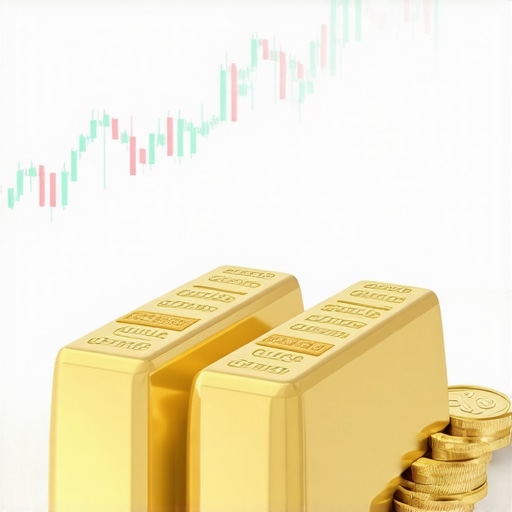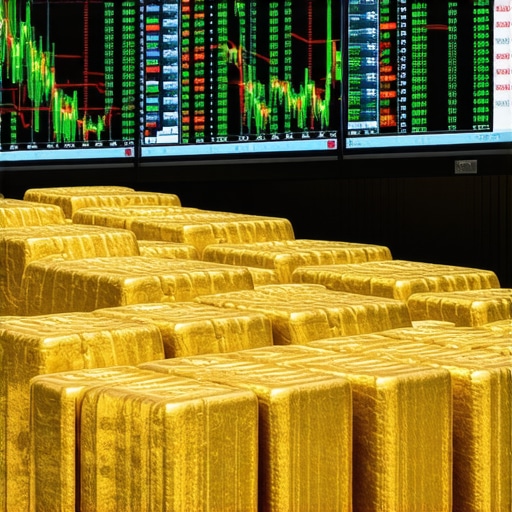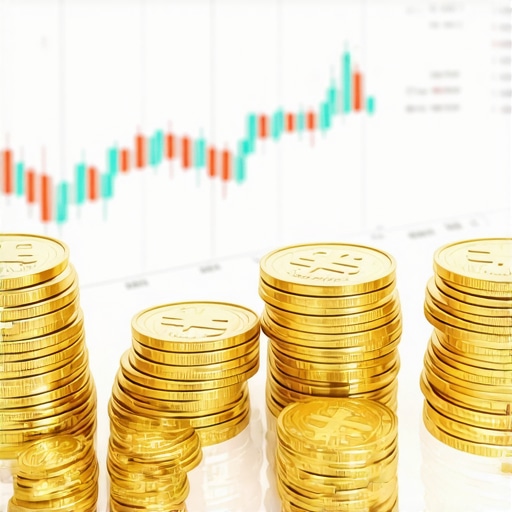Unveiling the Golden Thread: How Supply Dynamics Forge 2029’s Price Trajectory
In the intricate dance of global commodities, gold remains the timeless protagonist, its price movements not merely the result of demand but profoundly sculpted by the nuances of global supply. As we peer into the landscape of 2029, understanding how the ebb and flow of gold supply influences price trends offers investors and analysts a critical vantage point to anticipate market shifts with precision.
Mining Realities and Technological Innovations: The Supply Side’s Hidden Influencers
Extracting gold today is far from a static process. Technological breakthroughs in mining—ranging from enhanced ore processing to automation—are reshaping production volumes. While some regions face geological depletion and rising extraction costs, others leverage innovation to unlock previously inaccessible reserves. These developments create a complex mosaic of supply-side factors driving fluctuations in gold availability and, consequently, its pricing.
What are the key factors modulating global gold supply that impact price volatility in 2029?
Multiple elements converge to modulate supply volatility. First, geopolitical tensions in mineral-rich regions can disrupt mining operations or export routes, constricting supply unexpectedly. Second, regulatory shifts—such as environmental restrictions or mining royalties—directly affect production economics. Third, central banks’ gold reserves management, including buying or selling activities, dynamically adjusts market supply. Lastly, recycling gold from scrap supplies adds a flexible, albeit smaller, component to overall supply, influencing short-term price movements.
The Central Bank Factor: Strategic Reserves and Market Sentiment
Central banks wield significant influence over gold supply through their reserve policies. In 2029, many nations continue to adjust their strategic gold holdings as a hedge against currency volatility and geopolitical risks. Large-scale acquisitions or disposals by these institutions can tighten or loosen market supply dramatically. For instance, coordinated gold purchases by emerging economies signal confidence, often spurring bullish price trends, whereas reserve sell-offs may trigger price corrections. Understanding these maneuvers is vital for anticipating market sentiment and price directions.
Supply Chain Shocks and Environmental Constraints: The Unseen Price Drivers
Beyond production volumes, environmental regulations and global supply chain disruptions exert subtle yet powerful pressure on gold supply. Increasingly stringent sustainability mandates can delay mining projects or increase operational costs, indirectly inflating gold prices. Similarly, logistics interruptions—whether due to pandemics, trade disputes, or transportation bottlenecks—can temporarily constrain the flow of gold to markets, creating supply scarcity that reverberates in price spikes.
The Interplay of Supply and Demand: A Delicate Balance Shaping 2029’s Gold Market
While demand drivers like jewelry, technology, and investment remain pivotal, supply-side dynamics often dictate the price elasticity. For instance, limited supply growth amidst rising demand can accelerate price appreciation, while oversupply scenarios can suppress price momentum. Investors aiming to navigate 2029’s gold market would benefit from a holistic approach that integrates both demand trends and supply intricacies. For deeper analysis, exploring gold market analysis and supply-demand insights for 2029 offers valuable context.
Engage with this evolving topic by sharing your perspectives or questions below. Join a community of informed investors shaping smarter gold investment strategies in 2029.
Reference: World Gold Council’s 2023 report on gold demand and supply trends, providing foundational data and expert analysis on market drivers.
When Supply Shocks Hit Home: Personal Lessons from Market Volatility
Reflecting on my own experiences investing in gold, I recall a particularly volatile period in 2028 when unexpected supply chain disruptions caused a sharp spike in gold prices. Shipping delays and environmental restrictions in key mining countries suddenly tightened the gold supply, catching many investors off guard—including myself. It was a vivid reminder that beyond the numbers and charts, real-world events profoundly impact gold availability and pricing. This episode reinforced the importance of staying informed about geopolitical developments and supply logistics when managing gold investments.
How Can You Stay Ahead of Supply Trends Without Getting Overwhelmed?
This question often comes up in conversations with fellow investors. The gold market’s supply dynamics can seem daunting, especially when layered with geopolitical risks and technological changes. From my perspective, a practical approach involves regularly consulting trusted industry reports and expert analyses. For example, the World Gold Council provides comprehensive insights that distill complex supply-demand trends into actionable information. Additionally, subscribing to updates from reputable sources helps me track shifts in mining output, environmental regulations, and central bank activities without feeling overwhelmed.
Central Banks: The Quiet Giants in My Gold Strategy
One insight I’ve gained over time is the outsized role central banks play in shaping gold’s supply landscape. Their buying and selling decisions often fly under the radar but can dramatically influence market sentiment and prices. Watching emerging economies increase their reserves signals to me a bullish outlook for gold, prompting me to adjust my portfolio accordingly. Conversely, when reserve sell-offs occur, I become more cautious, aware that prices might face downward pressure. This nuanced understanding has been crucial in navigating the often unpredictable gold market.
Balancing Sustainability and Supply: What I’ve Learned About Environmental Constraints
Environmental policies are increasingly shaping how gold is mined and supplied globally. In my investment journey, I’ve noticed that mines complying with stringent sustainability standards tend to face higher operational costs, which can translate into reduced supply or higher prices. While this may initially seem like a hurdle, I view it as a signal of the market evolving responsibly, which ultimately supports gold’s long-term value. Keeping an eye on regulatory trends has helped me anticipate supply shifts before they fully materialize in the market.
For investors like us seeking deeper understanding, exploring detailed analyses such as gold market analysis and supply-demand insights for 2029 can offer practical perspectives to better align our strategies with evolving market realities.
What’s your take on balancing these supply challenges with investment opportunities? I’d love to hear your stories or questions—drop a comment below and let’s continue this conversation. Sharing experiences enriches our collective wisdom and helps us all navigate the gold market more confidently.
Innovative Supply Chain Solutions: Navigating Gold’s Future Amidst Global Disruptions
The gold supply chain in 2029 is increasingly characterized by its resilience and adaptability, driven by innovations that address complexities ranging from geopolitical risks to environmental compliance. Industry leaders are deploying advanced analytics and blockchain technologies to enhance traceability and streamline logistics, reducing bottlenecks that once severely impacted gold availability. These cutting-edge solutions not only mitigate risks but also foster trust among stakeholders by ensuring provenance and ethical sourcing—an aspect gaining unprecedented importance in investment decisions.
Moreover, strategic partnerships between mining companies, governments, and technology firms are pioneering pilot projects that integrate AI-driven predictive maintenance with real-time environmental monitoring. This synergy optimizes operational uptime while ensuring adherence to sustainability mandates, effectively balancing supply reliability with ecological responsibility.
How do blockchain and AI technologies fundamentally transform gold supply transparency and risk management in 2029?
Blockchain’s immutable ledger system enables unparalleled transparency in the gold supply chain, allowing investors and regulators to verify the origin and movement of gold at every stage. This reduces the risk of counterfeit or conflict gold entering the market and enhances compliance with international standards such as the Responsible Gold Mining Principles (RGMP). Simultaneously, AI algorithms analyze vast datasets including geological surveys, market trends, and geopolitical signals to forecast potential disruptions and optimize extraction schedules. Together, these technologies shift gold supply management from reactive to proactive, empowering stakeholders with data-driven insights that enhance price stability and market confidence (World Gold Council on Technology in Gold Mining).
Geopolitical Nuances: The Subtle Art of Supply Diplomacy Affecting Gold Prices
Beyond technological advances, the geopolitical landscape remains a labyrinthine factor shaping gold supply. Countries rich in gold reserves often leverage their mineral wealth as diplomatic instruments, creating supply contingencies that reverberate globally. For instance, trade embargoes or export quotas imposed in response to political disputes can abruptly constrict supply chains, triggering ripple effects on global prices.
Understanding the nuanced interplay between international relations and gold export policies requires expertise in geopolitical risk assessment, often integrating intelligence from economic sanctions, bilateral trade agreements, and regional stability indices. Savvy investors who incorporate these insights into their models gain a strategic edge, anticipating supply shocks before they manifest in market valuations.
Environmental Policy Evolution: Anticipating Regulatory Shifts Impacting Gold Extraction
Environmental governance is intensifying worldwide, with 2029 marking a turning point in regulatory frameworks that govern mining operations. Policies now emphasize not only minimizing ecological footprints but also ensuring social license to operate—mandating community engagement and equitable benefit sharing. This evolution translates into increased costs and operational complexities but also incentivizes innovation in sustainable mining practices.
For example, the introduction of carbon pricing mechanisms compels mining companies to adopt low-emission technologies and renewable energy integration, directly influencing production costs and, by extension, gold supply economics. Investors attentive to these regulatory trajectories can better forecast supply constraints and price adjustments, aligning their portfolios with environmentally progressive assets that promise long-term stability.
Integrating Supply Dynamics into Portfolio Strategy: An Expert Approach
To truly harness the insights from gold supply dynamics in 2029, investors must elevate their analytical frameworks beyond traditional metrics. This involves incorporating multi-dimensional data streams—technological adoption rates, geopolitical risk scores, regulatory policy timelines—into predictive models that assess supply elasticity under varied scenarios.
Engaging with specialized consultancy reports and subscribing to expert-led webinars can deepen understanding of these complex interdependencies. Moreover, diversifying holdings to include gold-backed environmentally conscious ETFs or shares in mining firms pioneering sustainable practices can mitigate risks associated with supply disruptions and regulatory shifts.
For those eager to refine their investment acumen, resources like the World Gold Council’s technology and innovation research provide granular analyses indispensable for strategic decision-making.
Ready to dive deeper into the sophisticated world of gold supply and price forecasting? Share your thoughts or questions below, and join our expert community in unraveling the complexities of 2029’s gold market. Collaborative dialogue sharpens insight and empowers smarter investment choices.
Decoding the Nexus of Advanced Technologies and Supply Chain Integrity
As 2029 unfolds, the integration of blockchain and artificial intelligence (AI) within gold supply chains is not merely a technical upgrade but a paradigm shift redefining transparency and risk mitigation. Blockchain’s decentralized ledger guarantees immutable provenance records, enabling stakeholders to trace gold from mine to market with unprecedented fidelity. This capability directly combats the infiltration of conflict or illicit gold, thereby enhancing investor confidence and fostering compliance with rigorous ethical standards like the Responsible Gold Mining Principles (RGMP).
Simultaneously, AI-driven analytics synthesize multifaceted datasets—including geological surveys, geopolitical developments, and market fluctuations—to predict supply disruptions and optimize extraction schedules. This proactive stance in supply management reduces volatility and aligns production with dynamic global demands.
How do blockchain and AI technologies fundamentally transform gold supply transparency and risk management in 2029?
The transformative power of these technologies lies in their complementary strengths: blockchain assures traceability and authenticity, while AI delivers predictive insights for strategic decision-making. This synergy empowers mining companies, regulators, and investors to anticipate potential bottlenecks or geopolitical risks before they manifest in price swings. According to the World Gold Council’s 2023 Technology and Innovation Report, these tools collectively enhance supply chain resilience and bolster market stability, marking a critical evolution in gold market infrastructure.
Geopolitical Strategy: Navigating the Complex Web of Supply Diplomacy
Geopolitical undercurrents continue to be potent forces sculpting gold’s supply landscape in 2029. Nations endowed with substantial gold reserves frequently employ export controls, trade embargoes, or strategic stockpiling as instruments of diplomacy or economic leverage. These maneuvers can precipitate sudden supply contractions, often catching markets unprepared and igniting price volatility.
To navigate this labyrinth, investors must adopt sophisticated geopolitical risk assessment models that integrate intelligence from economic sanctions, bilateral agreements, and regional stability analytics. Such foresight enables anticipation of supply shocks, informing agile portfolio adjustments that mitigate downside risks while capitalizing on emergent opportunities.
Environmental Governance and Sustainable Supply: The New Frontier in Gold Mining Economics
The intensification of environmental policies worldwide marks a watershed in mining operations, compelling companies to embed sustainability at their core. Regulatory frameworks now demand stringent carbon emissions reductions, robust community engagement, and transparent benefit-sharing mechanisms. Consequently, operational costs increase, potentially constraining supply and elevating gold prices.
Yet, this shift also catalyzes innovation—spurring adoption of renewable energy, carbon capture technologies, and eco-efficient extraction methods. For investors, aligning portfolios with environmentally progressive mining ventures not only mitigates regulatory risks but also capitalizes on the growing market premium for responsibly sourced gold.
Integrating Complex Supply Dynamics into a Robust Portfolio Strategy
Expert investors acknowledge that deciphering gold’s supply nuances requires transcending simplistic metrics. Incorporating multi-dimensional data—ranging from technological adoption curves and geopolitical risk indices to regulatory milestones—into predictive models is essential for anticipating supply elasticity and price trajectories.
Engaging with specialized consultancy insights and participating in expert-led forums enriches understanding of these interdependencies. Moreover, diversifying into gold-backed ETFs with sustainability mandates or equities in pioneering mining firms can buffer against supply chain disruptions and regulatory volatility.
For comprehensive analyses, the World Gold Council’s Technology and Innovation Research offers indispensable resources for informed decision-making.
Ready to elevate your investment strategy by mastering the multifaceted supply dynamics of gold in 2029? Share your insights or pose questions below to join a sophisticated community committed to navigating gold market complexities with expertise and foresight.
Frequently Asked Questions (FAQ)
What are the main factors affecting gold supply in 2029?
Gold supply in 2029 is influenced by multiple intersecting factors including technological advancements in mining, geopolitical tensions affecting mineral-rich regions, regulatory frameworks emphasizing environmental sustainability, central bank reserve policies, and supply chain logistics. These elements collectively determine the volume and reliability of gold entering the market, thereby impacting price dynamics.
How do central banks impact gold prices through their reserve policies?
Central banks manage gold reserves as strategic assets, buying or selling gold to stabilize their currencies or hedge against economic uncertainties. Large-scale purchases by emerging economies can tighten market supply and trigger bullish price trends, while significant sell-offs may increase supply and exert downward pressure on prices. Monitoring central bank activities offers key insights into future market sentiment and price direction.
In what ways are blockchain and AI transforming gold supply chains?
Blockchain technology provides an immutable, transparent ledger verifying the provenance and movement of gold, reducing risks of counterfeit or conflict gold. AI leverages data analytics to predict supply disruptions, optimize extraction schedules, and enhance operational efficiencies. Together, these technologies enable proactive risk management, improve supply chain resilience, and contribute to market stability by aligning supply with demand more effectively.
How do environmental regulations influence gold supply and pricing?
Stringent environmental policies increase operational costs and complexity for gold mining companies, potentially reducing supply availability. Requirements such as carbon pricing, renewable energy integration, and community engagement raise barriers to production but encourage sustainable practices. These factors tend to elevate gold prices over time by constraining supply while supporting long-term market confidence in ethically sourced gold.
What geopolitical risks should investors consider regarding gold supply?
Geopolitical risks include trade embargoes, export restrictions, political instability in gold-producing regions, and diplomatic tensions that can abruptly limit gold exports. Sophisticated risk assessment models incorporating sanctions, bilateral agreements, and regional stability help anticipate supply shocks. Investors leveraging this intelligence can better prepare for price volatility and adjust portfolios to mitigate adverse impacts.
How can investors integrate supply dynamics into their gold investment strategies?
Investors should adopt multi-dimensional analytical frameworks incorporating technological trends, geopolitical risk indices, and evolving regulatory landscapes into predictive models. Diversifying portfolios with gold-backed ETFs emphasizing sustainability and shares in innovative mining companies can reduce exposure to supply disruptions. Continuous engagement with expert research and industry reports enhances decision-making in a complex supply environment.
What role does recycling play in the gold supply chain?
Recycling contributes a flexible, albeit smaller, portion of gold supply by recovering gold from scrap and electronic waste. While it cannot fully replace mined gold, recycling helps alleviate short-term supply constraints and supports sustainability goals. Its influence on price is generally modest but becomes more significant during periods of mining disruption or heightened demand.
Why is supply chain transparency increasingly important in gold markets?
Transparency ensures ethical sourcing, compliance with international standards, and investor confidence. Technologies like blockchain enable traceability from mine to market, reducing risks of conflict gold and fraud. Transparent supply chains attract socially conscious investors and can command premium pricing, reflecting growing market emphasis on responsible investment.
Can supply chain innovations mitigate the impact of global disruptions on gold supply?
Yes, innovations such as AI-driven predictive maintenance, advanced analytics, and blockchain-enhanced traceability improve operational resilience and logistics efficiency. These tools help anticipate bottlenecks and reduce delays caused by pandemics, trade disputes, or environmental regulations, thus stabilizing supply and moderating price volatility.
How important is it to monitor regulatory shifts for gold investors?
Monitoring regulatory developments is crucial as they directly affect mining costs, operational feasibility, and environmental compliance. Early awareness of policy changes enables investors to anticipate supply constraints or opportunities in sustainable mining ventures, aligning portfolios with assets likely to benefit from evolving governance frameworks.
Trusted External Sources
- World Gold Council (WGC): As a leading authority on gold market research, the WGC offers comprehensive data and expert analyses on gold demand, supply trends, technology adoption, and sustainability standards. Their reports underpin informed investment strategies and market forecasting.
- International Council on Mining and Metals (ICMM): This organization provides insights into sustainable mining practices, environmental regulations, and social responsibility initiatives shaping gold extraction economics globally, helping investors understand regulatory impacts.
- United States Geological Survey (USGS): The USGS publishes detailed mineral commodity summaries and assessments, delivering authoritative geological data and production statistics essential for evaluating supply fundamentals.
- McKinsey & Company – Mining & Metals Practice: McKinsey offers strategic consultancy reports and market outlooks that integrate technological innovation, supply chain management, and geopolitical risk assessment relevant to the gold sector.
- Bloomberg Intelligence – Metals & Mining: Bloomberg provides real-time market data, expert analysis, and geopolitical risk tracking that supports dynamic investment decision-making in gold markets.
Conclusion
Understanding the intricate supply dynamics shaping gold prices in 2029 is indispensable for investors aiming to navigate an increasingly complex market. Technological advancements, from blockchain to AI, are revolutionizing supply chain transparency and risk mitigation, while geopolitical undercurrents and evolving environmental policies introduce nuanced challenges and opportunities. Central banks continue to exert significant influence through strategic reserve management, impacting market sentiment and price trajectories. Incorporating multi-dimensional data streams and engaging with expert resources empower investors to anticipate supply elasticity and price shifts with greater precision.
By synthesizing these factors into robust portfolio strategies—balancing innovation, sustainability, and geopolitical insight—investors can position themselves advantageously for the evolving gold landscape. We invite you to share your perspectives, pose questions, and explore related expert content to deepen your mastery of gold market complexities. Together, we can cultivate smarter, more resilient investment approaches for 2029 and beyond.











This comprehensive analysis really highlights how multifaceted the gold supply landscape is heading into 2029. I’ve personally followed the rise of blockchain and AI in mining operations, and it’s fascinating to see how these technologies are not just enhancing transparency but also enabling more proactive risk management. The emphasis on environmental policies and geopolitical risks further underscores how dynamic and interconnected this market truly is. I recall a recent shift where a major country’s export restrictions abruptly tightened, leading to a noticeable spike in gold prices—and it made me realize how crucial it is for investors to stay informed about political and regulatory changes.
With so many moving parts—technological innovations, environmental mandates, geopolitical maneuvering—what strategies do you think investors can adopt today to better anticipate these shifts and mitigate potential risks? Are diversifying into sustainable and technologically advanced mining stocks a solid way forward in this evolving landscape? I’d be interested to hear others’ experiences or thoughts on balancing these variables for a resilient long-term portfolio.